Space masterpieces: shortlist for the Astronomical Photographer of the Year 2024 competition (20 photos)
The organizers of the prestigious Astronomical Photographer of the Year competition have presented a selection of stunning images shortlisted for 2024. This annual competition is the world's largest space photography competition. 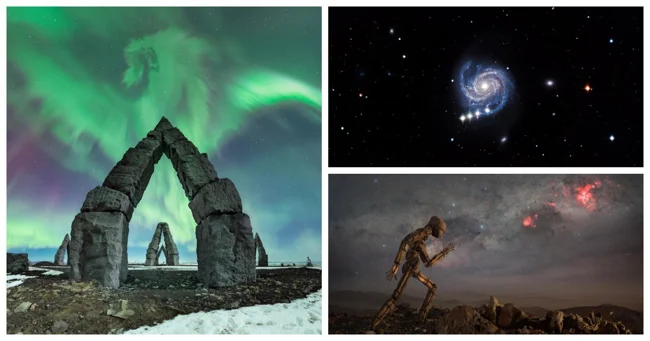
From majestic starscapes to mesmerizing images of moons and suns, the finalists' work showcases the beauty and diversity of outer space. Now in its 16th year, the Astronomy Photographer of the Year competition attracts thousands of entries from talented photographers around the world. We invite you to take a look at some of these space masterpieces. 
"Night with the Valkyries" by Jose Miguel Picon Chimelis. Hvalnesviti, Iceland
“This photo is a panoramic view of Mount Eystrahorn. This night, I think, was one of the most amazing nights of my entire night photography experience. There was a forecast for Storm KP7 [a severe geomagnetic storm that could cause aurora and disrupt power systems] and I was excited to see what I would see. I never imagined that I would see such colors in the sky; it was a spectacle that is difficult to describe.” 

"Whale Swimming on the Sun" by Eduardo Schaberger Pupo. Rafaela, Santa Fe, Argentina
“When I used my telescope that day, I was overcome with surprise and amazement: I saw an extraordinary filament, shaped like a huge plasma whale, swimming along the solar surface above the disk. It was truly amazing to observe the singularity of this imposing figure. This plasma structure not only reveals solar dynamics, but also highlights our mind's amazing ability to perceive recognizable shapes in abstract patterns. This phenomenon is known as pareidolia,” explains Eduardo. — To take this photo, I recorded two videos (one for the disk, one for the prominences), each consisting of 850 frames, and stacked 100 of them using Autostakkert!, applying wavelets using ImPPG. Then in Photoshop I composited the two images and added color to them.”

"Abandoned House" by Stefan Lieberman. Garub, Namibia
“In the middle of the Namib Desert you can find an abandoned house, and right above it rises the Milky Way. I installed some lights around the house, set up my star tracker, and took advantage of the opportunity. Through the veil of clouds, halos around the stars created a dream-like effect. The sky was captured using a star tracker to lower the ISO (light sensitivity level)."

Night Observations by Jacob Sachner. Roque de los Muchachos, La Palma, Canary Islands, Spain
“What you see here is the Isaac Newton telescope on the edge of the telescope building complex on La Palma. It is gigantic and sometimes makes scary noises at night. This composition has been my dream for a very long time. Many astrophotographers focus only on the center of the Milky Way, which, of course, looks beautiful, but obscures other interesting areas of the galaxy, says Jacob. — The Cygnus region, with its bright and vibrant star-forming regions, is one of my favorite parts of the night sky. You can see it in the upper right corner of the photo. This photo is a panorama created with a 135mm lens. I love the special look and incredible depth it gives to the photo. It's a lot of work, but I think it's worth the effort."
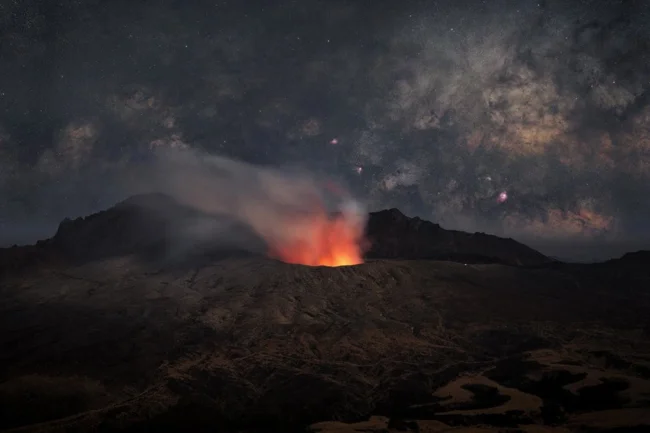
"Earth and Milky Way Galaxy Show" by Yoshiki Abe. Aso, Kumamoto Prefecture, Japan
“Mount Aso in Kumamoto Prefecture is the collective name for five peaks, often called the “five mountains of Aso,” says the photographer. — At the top of Nakadake there is a volcanic crater that is still active. I was lucky enough to photograph a reflection that could only be seen at night. I wanted this image to show how the Milky Way has witnessed volcanic activity on Earth since prehistoric times. This is a composite photograph in which the foreground and sky are photographed separately, but without moving the tripod. The Milky Way was composited and enhanced in PixInsight and combined with the foreground in Photoshop.”

"SNR G156.2+5.7, a faint supernova remnant in the constellation Auriga", Bray Falls. Auberry, California, USA
“SNR G156.2+5.7 is a beautiful and faint supernova remnant (SNR) in the constellation Auriga. It is located behind the dark clouds of the Taurus and Auriga molecular complex, which are very close to the solar system. This means we'll have to look at the supernova remnant through dust clouds in deep space. Luckily, there are enough breaks in the clouds to see the incredible structure. This SNR has an amazing H-alpha blowing feature that creates a thin, lacy bubble that wraps around traditional SNR shockwave filaments,” explains Bray.

"Arctic Dragon" by Karina Letelier Baeza. Raufarhöfn, Iceland
“This panorama of an aurora like a large dragon above the rock pyramids was the result of a geomagnetic storm (G2 level) caused by a coronal mass ejection earlier in the day. As a result, intense red-greenish aurora were observed throughout the night. The location was the Arctic Stonehenge landmark, which has rich cultural significance for Icelanders, and it was the only place in Iceland with clear skies that night,” says Karina.

"Galaxy Eater" by ShaRA (Shared Remote Astrophotography) team. El Sauz Observatory, Rio Hurtado, Chile
“Is this the cosmic sandworm of Arrakis from Dune or the terrifying Graboid from Tremors?” asks ShaRa member Alessandro Ravagnin.
“CG4 (Cometary Globule 4) is a complex of nebula and dust of a very peculiar shape, located in the southern constellation Puppy. The “head” of the galactic worm measures about 1.5 light years, and the appendage that follows the head and is directed in the opposite direction relative to the famous Vela supernova remnant is about eight light years long. This image is the result of the work of a team of astrophotographers; We put our heads together, rented a 500mm Newtonian telescope from Chilescope, processed the raw files, voted as a group on the best images, and combined them into PixelMath.”
© ShaRa Group: Marcella Botti (Italy), Vikas Chander (India), Massimo Di Fusco (Italy), Aigen Erkaslan (Switzerland), Marco Firenzuoli (Italy), Vincenzo Fiore (Italy), Vincenzo Fermo (Italy), Antonio Grisuti ( Italy), Andrea Lorio (Italy), Vittorio Liberti (Italy), Rolando Ligustri (Italy), Donato Llose (France), Antonio Loro (Italy), Giampaolo Michieletto (Italy), Gianluigi Pazienza (Italy), Christian Privitera (Italy) , Alessandro Ravagnin (Italy), Francesco Tiano (Italy), Cristiano Trabuio (Italy), Egidio Vergani (Italy)

"Serpentine" by Paul Haworth. Snettisham Beach, King's Lynn, Norfolk, UK
“On a new moon in April 2023, I went to Snettisham Beach, famous for its vast tidal mudflats that attract migratory birds in staggering numbers,” Paul recalls. “My subject for the evening was a large, dilapidated pier built during the Second World War to allow boats to transport gravel taken from nearby quarries to build the concrete runways needed for American bombers based in the UK. The whole night I was surrounded by incredible bird sounds - they didn't stop, and it was a fantastic soundtrack to the crystal clear night. I called this image "Serpentine" because I love the winding channel in the mud bog that mirrors the passing stars, and the wonderful scaly texture of the mud cracks."
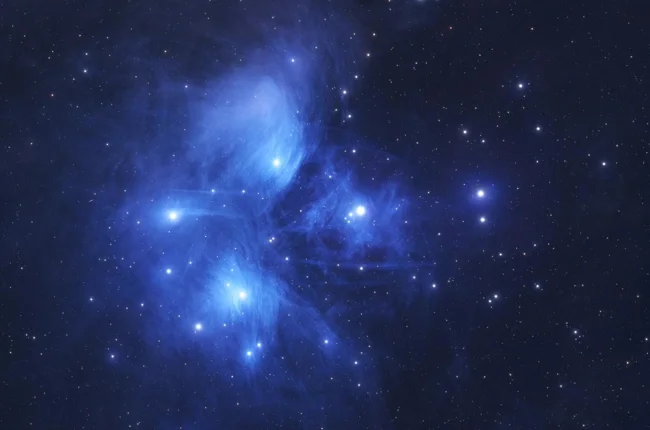
"Blue Parts M45: Pleiades", Sandor Bilicki. AstroCamp Nerpio Observatory, Albates, Castile-La Mancha, Spain
“I started doing astrophotography in February last year,” says the author of the photo. — Due to light pollution and atmospheric conditions in Budapest, I rented space for my equipment at the Spanish AstroCamp Observatory and took these photos while I was there. The Pleiades are very popular among astrophotographers, but there are so many tiny details to discover that it was a huge learning experience for me in processing.”
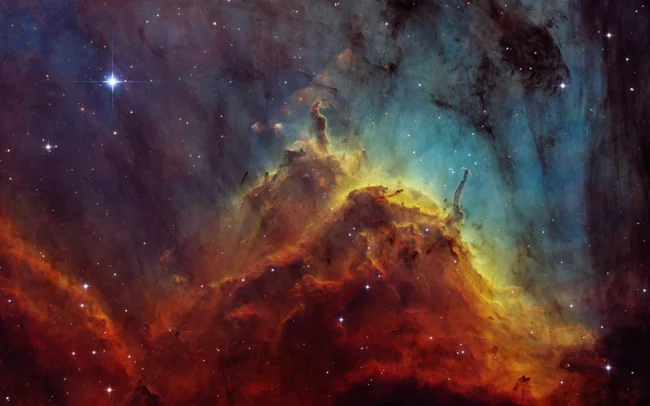
"Misty Mountains", Benche Thoth. Sedliget, Pest, Hungary
“This image is a close look at IC 5070, the Pelican Nebula. I used narrowband filters to capture the image and created a color image using the Hubble Palette method. The fine dust and gas structures reminded me of the fog on the mountains in the rays of the rising Sun, hence the name, says Benche. “During the processing process, I really wanted to show this aesthetically, as well as the details of the dust itself. The image also clearly shows some HH objects [Herbig-Haro objects—bright regions or nebulae around newborn stars], even with structural details."

"M100 (Phene Galaxy) and Ceres" by Damon Mitchell Scotting. El Sauz Observatory, Rio Hurtado, Chile
“Perspective is important in life, especially when observing deep space,” Damon says. “I had the rare and wonderful opportunity to capture a dwarf planet, more than a billion times smaller than its galactic counterpart, transiting behind the spiral arms of the galaxy. The planet Ceres shines brighter than the galaxy and streaks across our night sky at terrifying speed. For this image, I took several long exposures over eight hours to show the beauty of the Fæne galaxy and the relatively fast speed of Ceres."

Run to Kareena by Vikas Chander. Kunene Region, Namibia
“Deep in the north-west of Namibia, in the scorched desert, where you can drive hundreds of kilometers without meeting a single person, the artist works tirelessly. Throughout the desert there are numerous stone sculptures that blend seamlessly into the environment. They are known as the “Lonely People of Kaokoland” [as the region was formerly called] and it is unclear who installed them and where exactly, but my desire to photograph them all continues, says Vikas. “I took a long exposure of the stone running man and then lighted and blended it in Photoshop. I then moved the tripod to get a clear view of the horizon for easy compositing. The Carina Arm (one of the Milky Way's arms) was tracked and then a stack of eight images was blended with a foreground image of clouds, haze and horizon glow to create a smooth transition between the ground and sky."

"International Space Station: Daytime Transit of the Moon", Kelvin Hennessy. Gold Coast, Queensland, Australia
“This image shows the International Space Station (ISS) passing against the backdrop of the Moon, which is 51 percent illuminated. I used Ed Morana's ISS Transit Prediction app to find a suitable transit path and confirmed it in Stellarium. Finding a suitable location in the city was the most challenging part of the shoot. I used Google Earth and Google Street view to find a suitable location with clear skies and parking along a very narrow transit corridor.”

"Total Solar Eclipse" by Gwenael Blanc. Exmouth, Western Australia, Australia
“A total solar eclipse is one of the most beautiful spectacles nature has to offer. Everyone should experience this at least once in their life. In April 2023, I traveled to Australia to see 62 seconds of total eclipse. Photos don’t convey this miracle,” says Gwenael. “In this collage, I wanted to show the beauty of the corona (which looks like a flower so close to solar maximum), as well as the pink chromosphere, prominences and “Bailey beads” [the reflections of sunlight that show through due to the uneven terrain of the Moon]." in Photoshop. I layered seven photos for the background and six others for the chromosphere and prominences.”
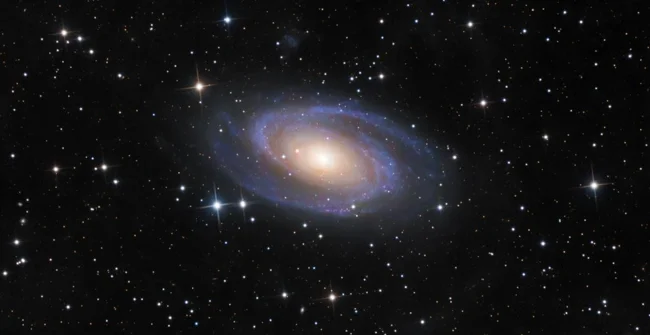
"M81, a Magnificent Spiral Galaxy" by Holden Aimar. Brownstown, Michigan, USA
“M81, also known as the Bode Galaxy, is located about 11.75 million light-years away in the constellation Ursa Major. It is one of the brightest galaxies in the night sky. The Integrated Flux Nebula (IFN) is visible very faintly in the background of the image. IFN is dust outside the galactic plane of the Milky Way that is illuminated only by Milky Way stars,” says Holden.

“Giant solar prominence in motion”, Miguel Claro. Dark Sky Alqueva Observatory, Evora, Portugal
“This is a still image from a series of time-lapses of chromospheric activity, showing a giant prominence in motion. You can see many interesting changes in its shape. This giant stretches thousands of kilometers around the limb of the Sun and is several times larger than the Earth. For comparison, its width is greater than the width of Saturn's rings, says Miguel. “We also see many small spicules surrounding the solar disk and a rapidly growing prominence emanating from the sunspot, while the chromosphere itself exhibits slower motion. The conditions were good, so I was able to take a time lapse of about 248 photos. The end result is a high definition 4K film consisting of approximately 1 hour and 20 minutes of photographs.”

"Martian Dementors", Leonardo DiMaggio
“I was working on a project with various images from the Mars Reconnaissance Orbiter (MRO) missions when I found this image that really stood out. If you abstract from the image, the perspective shifts, and the Martian landscape turns into something very eerie and atmospheric,” explains Leonardo. “I cropped parts of the image and tried to increase the clarity as well as the shadows to give the impression of the legs of living creatures, while trying to maintain the overall sense of darkness of the photo.”

"Saturn with Six Moons" by Andy Casely. Blue Mountains, New South Wales, Australia
“The decreasing tilt of Saturn's rings is helping the big orange moon Titan move closer to Saturn from our perspective than it has in the last ten years,” says Andy. — The usually distant Titan joined the family portrait of the moons this September. In the center of the image, Tethys is about to disappear behind Saturn, Rhea, Enceladus and Mimas are to the left, and Dione is in the lower right corner. The planet’s shadow on the rings is clearly visible, as are the divisions of Cassini and Encke.”

